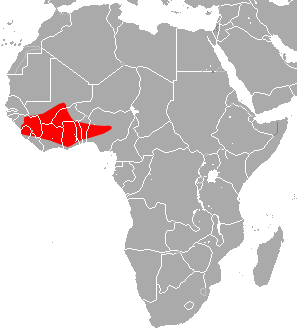Jones's roundleaf bat facts for kids
Quick facts for kids Jones's roundleaf bat |
|
|---|---|
| Conservation status | |
| Scientific classification | |
| Genus: |
Hipposideros
|
| Species: |
jonesi
|
 |
|
| Jones's roundleaf bat range | |
The Jones's roundleaf bat (scientific name: Hipposideros jonesi) is a type of bat. It belongs to a family of bats called Hipposideridae. This special bat lives only in southern West Africa. You can find it in places like dry forests, savannas, grasslands, rocky areas, and even underground caves.
Contents
What is Taxonomy?
Taxonomy is how scientists name and group living things. The first Jones's roundleaf bat was found in Makeni in 1947. It was collected by T. S. Jones from the Sierra Leone Department of Agriculture.
Later, a scientist named Hayman looked closely at the bat at the British Museum. He realized it was a new species, meaning it was different from any other known bat. So, he named it after T. S. Jones. This bat is part of a group of bats called the bicolor species group.
What Does It Look Like?
The Jones's roundleaf bat is a small microbat. Both male and female bats look very similar. It has a special noseleaf on its face and very large ears.
Its fur is fine, thick, and feels silky. The hairs on its back are about 10-11 millimeters long. The fur on its back is usually grayish-brown. The hairs are dark gray at the bottom and gray at the tip.
The fur on its belly is lighter. These hairs are pale gray or brown with a whitish tip. Some of these bats can also have an "orange phase." This means their back fur is a tawny-orange or cinnamon color. Its wings and the skin between its legs (called the interfemoral membrane) are dark gray.
Its Unique Noseleaf
This bat has a special noseleaf that is longer than it is wide. It has a large part between its nostrils that partly hides them. The noseleaf also has small flaps on each side.
The back part of the noseleaf is long and divided into four sections. The top edge of the noseleaf is curved. The front part is broad and covered in hair, covering its snout.
Its Big Ears
The Jones's roundleaf bat has very large ears that are separate from each other. Its ears can be almost half the length of its forearm! They are wide and shaped like a triangle with a pointed tip. Each ear has 11 folds inside. There's also a clear fold on the antitragus, which is a small bump in front of the ear canal.
What Does It Eat?
This bat is insectivorous, which means it eats insects.
Where Does It Live?
The Jones's roundleaf bat has been found in several countries in West Africa. These include Burkina Faso, Ivory Coast, Ghana, Guinea, Liberia, Mali, Nigeria, and Sierra Leone.
These bats usually live in small groups of a few dozen individuals. They like to roost, or rest, in caves, boulder caves, and old mine shafts. They can live in many different types of places. This includes tropical moist forests, dry Sahel vegetation, and even in mountain areas. They have been found at heights up to 1350 meters (about 4,400 feet) above sea level.
Why is it Near-Threatened?
The IUCN (International Union for Conservation of Nature) has listed the Jones's roundleaf bat as near-threatened. This means it could become endangered in the future if we don't protect it.
One big problem for these bats is that their roosting places, like caves, are being damaged. They might also be hunted by people for food. The bat's population really depends on having safe caves to rest in during the day.
Right now, there are no specific laws or international agreements to protect this bat. Also, we don't know if these bats live in any protected areas, like national parks.


